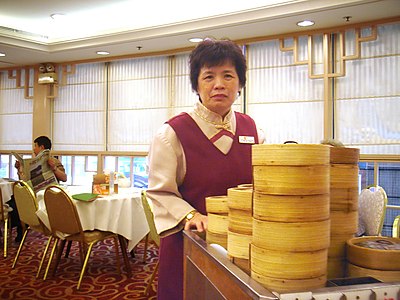Yum Cha
Yum Cha auch als Ban Ming bekannt, ist ein chinesisches Teeritual welches das Teetrinken und den Verzehr von Dim Sum (kleine, chinesische Gerichte) beinhaltet. Yum Cha bedeutet in Kantonesisch wörtlich "Tee trinken", während Ban Ming "Verkostung von Tee" bedeutet. Ausserhalb von China, wird oft der Ausdruck Dim Sum für das ganze Teeritual an Stelle von Yum Cha verwendet.
Dim sum can be cooked by steaming and frying, among other methods. The dim sum are usually small and normally served as three or four pieces in one dish. It is customary to share dishes among all diners on the same table. Because of the small portions people can try a wide variety of food.
Traditionally, the cost of the meal was calculated based on the number and size of dishes left on the patron's table at the end. In modern yum cha restaurants, dim sum servers sometimes mark orders by stamping a card on the table. Servers in some restaurants even use different stamps so that sales statistics for each server can be recorded.
Dim sum
Ähnlich wie beim englischen Teeritual sind beim Yum Cha die Snacks die zum Tee gereicht werden genauso wichtig wie der Tee selbst. Diese Lebensmittel werden zusammenfassend als "Dim Sum" bezeichnet. Das vielfältige Angebot an kleinen Speisen kann durchaus Frühstück, Mittagessen oder das Abendessen ersetzen. Die Gerichte werden in der Regel gedämpft oder gebraten und können herzhaft oder süss sein. Dazu gehören gedämpfte Brötchen, Teigtaschen und verschiedene Rollen (z.B. Frühlingsrollen). Als Zutaten wird verwendet was die Chinesische Küche hergibt. Unter anderem Ei, Rindfleisch, Hühnchen, Schweinefleisch, Garnelen und Tofu. Typische Süssspeisen sind Eiertorte, Tapioka und -Mangopudding. Viele Yum Cha Restaurants bieten auch Platten mit gedämpftem Gemüse und Braten sowie Reisbrei und Suppen.
Dim Sum sind in der Regel klein Häppchen von denen zwei bis drei Stück in euinem Bambuskorb serviert werden. Es ist üblich die Speisen in die Mitte des Tisches zu stellen und sie zu teilen. Auf diese Art können viele unterschiedliche Speisen probiert werden.
Eating utensils
Chopsticks, a pair of small even-length tapered sticks, are the traditional eating utensils used to yum cha. Chopsticks are commonly made of plastic in the Chinese restaurants. Held between the thumb and fingers of the working hand they are used as tongs to pick up portions of food or to sweep rice and small particles of food into the mouth from the bowl. Dim sum dishes are served in small portions and therefore convenient for eating with chopsticks. Many rules of etiquette govern the proper use of the chopsticks.
Toothpicks are frequently used between courses, as it is believed that the aftertaste of one course should not be allowed to ruin one's enjoyment of the next course. Toothpicks are ideal and socially acceptable for picking up those meal items which often defy the best chopstick approach, such as slippery button mushrooms and jellyfish slices served with sesame oil.
Essstäbchen, a Paar von kleinen geraden Länge verjüngt Sticks, sind die traditionellen Essen Utensilien verwendet, um yum cha. Chopsticks werden häufig von Kunststoff in den chinesischen Restaurants gemacht. Statt zwischen Daumen und Finger der Arbeitshand sie eingesetzt als Zange abholen Portionen oder Reis und kleinen Teilchen von Nahrungsmitteln in den Mund fegen aus der Schüssel. Dim Sum Gerichte werden in kleinen Portionen serviert und damit praktisch für Essen mit Stäbchen. Viele Regeln der Etikette regeln die ordnungsgemäße Verwendung der Stäbchen.
Zahnstocher s werden häufig zwischen den Gängen verwendet, wie es wird angenommen, dass die Nachgeschmack von einem Kurs sollte nicht erlaubt, seine Freude an den nächsten Kurs zu ruinieren werden. Zahnstocher sind ideal und sozial verträglich für die Kommissionierung bis diese Mahlzeit Artikel, die häufig trotzen der besten chopstick Ansatz, wie rutschig Champignons und Quallen Scheiben serviert mit Sesamöl.
Customs and etiquette
It is customary to pour tea for others before filling one's own tea cup. It is most gracious to be the first to pour tea.
When tea drinkers tap the table with two (occasionally one) fingers of the same hand, an action known as finger kowtow, it is an expression of gratitude to the member of the party who filled their cups. According to a just-so story, this gesture recreates a tale of Imperial obeisance and can be traced to the Qianlong Emperor, a Qing Dynasty emperor who used to travel incognito. While visiting South China, he once went into a teahouse with his companions. In order to maintain his anonymity, he took his turn at pouring tea. His stunned companions wanted to kowtow for the great honour but to do so would have revealed the identity of the emperor. Finally, one of them tapped three fingers on the table (One finger representing their bowed head and the other two representing their prostrate arms) and the clever emperor understood what he meant. From then on, this has been the practice.



